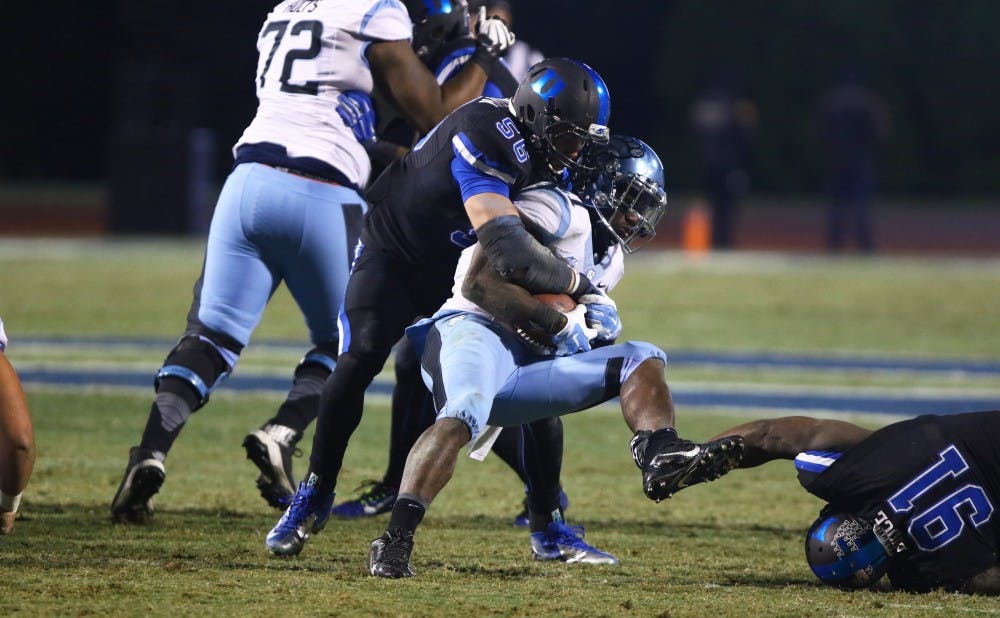Everybody on Duke's defense seems to want to play linebacker.
With the graduation of senior David Helton and the loss of redshirt senior Kelby Brown to an ACL tear, converted safeties Zavier Carmichael and Dwayne Norman will man the middle of the field for the Blue Devils. Up front, Duke's defensive ends will occasionally get the chance to play a hybrid linebacker position as well.
After the departure of harder-hitting, more traditional linemen like Jordan DeWalt-Ondijo and Dezmond Johnson in the offseason, the Blue Devils have placed more emphasis on speed, agility and intellect on the defensive front. With this transition from power to speed, Duke has patented a new approach to counter opposing offensive lines—the “devil position.”
“It’s kind of a mix between [the defensive end] and an outside linebacker who might have a little more pass coverage responsibility,” senior defensive end Deion Williams said. “We get to stand up and kind of read as a linebacker would do, but we’re still close enough to be able to be a force on the line.”
Although a defensive end traditionally lines up in a three-point stance, with both feet and one hand planted firmly in the ground, the “devil position” creates a unique hybrid between a linebacker and defensive lineman up front. Stepping back from the line, raising up into a two-point stance and mirroring an additional outside linebacker provides more options to rush into the trenches or drop back in pass coverage on the outside.
The transition to the “devil position” seems intuitive for a defensive front lacking in size. Although Trevon McSwain—a freshman from Suwanee, Ga.—is the largest defensive end on the roster at 265 pounds, the average size of the top four players on the depth chart is just 242.5 pounds, putting the Blue Devils at a significant size disadvantage in the trenches against the typical ACC offensive line.
Three of Duke's four top defensive ends have linebacker experience at the collegiate level, making the transition to the hybrid position more natural. Williams shifted from linebacker to defensive end during spring drills this year, and redshirt seniors Britton Grier and Kyler Brown switched during spring practice in 2013 and 2014, respectively. Relying on former tendencies they developed in their time as linebackers, the unit has been able to focus on the speed, agility and reaction required in the new position.
“We looked at a defensive end position that had a deficit with all of our graduations and we said we had these linebacker types in Kyler and Deion, and now even Dom McDonald has gotten into the mix, so [we thought] let’s grow the idea,” Duke defensive coordinator Jim Knowles said. “Sometimes [DeWalt-Ondijo] stood up and he kind of roamed around and rushed from different places [last year]. We want to add to that further, taking guys who have linebacker skills and experience to be able to cover the pass or rush.”
The idea is not entirely new, however. Knowles has developed the position at various stops throughout his coaching career on the defensive side of the ball, refining the concept as the defensive coordinator at Western Michigan from 2001-02 with current New York Jets linebacker Jason Babin.
With Babin working out of what is now called the “devil position,” the Broncos led the MAC in total defense in 2002 and ranked 28th nationally. Babin was named the MAC Defensive Player of the Year after posting 26 tackles for loss and 15 sacks as a junior.
By bringing the "devil position" to Durham, Knowles—now in his sixth season—has injected a new outlook into the defensive front for the Blue Devils. But in order for the concept to replicate the success of Babin and the 2002 Western Michigan squad, Duke’s defensive front will have to rely heavily on communication.
Since Brown played has logged time as a linebacker for three seasons, the Matthews, N.C., native will take the reigns directing the rest of the down linemen on how to approach the new role.
“Being a linebacker before, I already know what the defensive front should be doing,” Brown said. “The linebacker is the quarterback of the defense and having been doing that, I can also help the linebackers out with whatever the defensive line needs to know. I can be talking throughout the defensive line.”
If communication breaks down on the defensive front, however, the Blue Devils could be on their heels or lying on their backs defending larger teams with stout offensive lines. As a result, the traditional defensive ends will have to be aware of the “devil” and how each defensive package corresponds to the assignments on the field.
“The ‘devil’ and the defensive end—[they] kind of work hand-in-hand,” Grier said. “If I’m playing defensive end and Kyler Brown is playing ‘devil’ and we get stuck on one side, we just communicate. Communication is key.”
Given all of the changes in Durham this season, the implementation of the “devil position” will serve as another piece of the puzzle in rebuilding the front of the 4-2-5 defense in 2015. Opening the season Thursday against Tulane on the road will allow Duke to test the waters with its new scheme against the successful and experienced ground game of the Green Wave, which burned the Blue Devils for 231 yards on the ground in last year's meeting between the teams.
Ryan Hoerger and Brian Pollack contributed reporting.
Get The Chronicle straight to your inbox
Signup for our weekly newsletter. Cancel at any time.

